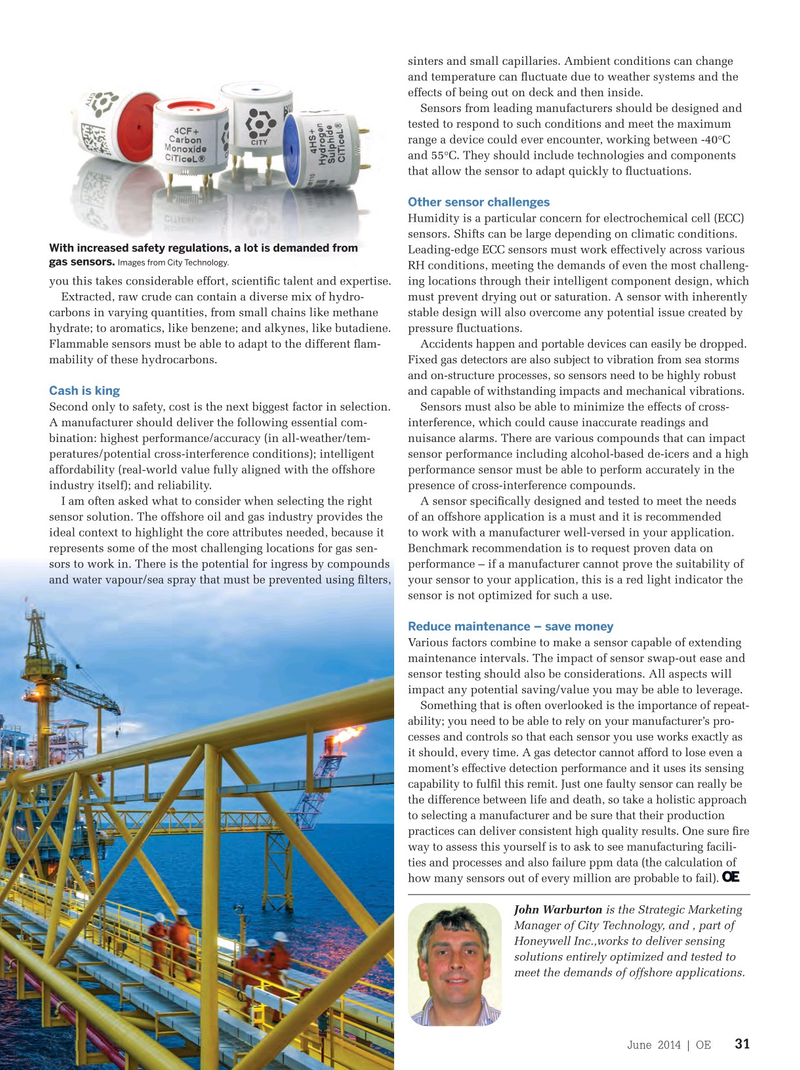
Page 29: of Offshore Engineer Magazine (Jun/Jul 2014)
Read this page in Pdf, Flash or Html5 edition of Jun/Jul 2014 Offshore Engineer Magazine
sinters and small capillaries. Ambient conditions can change and temperature can ? uctuate due to weather systems and the effects of being out on deck and then inside.
Sensors from leading manufacturers should be designed and tested to respond to such conditions and meet the maximum range a device could ever encounter, working between -40°C and 55°C. They should include technologies and components that allow the sensor to adapt quickly to ? uctuations.
Other sensor challenges
Humidity is a particular concern for electrochemical cell (ECC) sensors. Shifts can be large depending on climatic conditions.
With increased safety regulations, a lot is demanded from
Leading-edge ECC sensors must work effectively across various gas sensors. Images from City Technology.
RH conditions, meeting the demands of even the most challeng- you this takes considerable effort, scienti? c talent and expertise. ing locations through their intelligent component design, which
Extracted, raw crude can contain a diverse mix of hydro- must prevent drying out or saturation. A sensor with inherently carbons in varying quantities, from small chains like methane stable design will also overcome any potential issue created by hydrate; to aromatics, like benzene; and alkynes, like butadiene. pressure ? uctuations.
Flammable sensors must be able to adapt to the different ? am- Accidents happen and portable devices can easily be dropped. mability of these hydrocarbons. Fixed gas detectors are also subject to vibration from sea storms and on-structure processes, so sensors need to be highly robust
Cash is king and capable of withstanding impacts and mechanical vibrations.
Second only to safety, cost is the next biggest factor in selection. Sensors must also be able to minimize the effects of cross-
A manufacturer should deliver the following essential com- interference, which could cause inaccurate readings and bination: highest performance/accuracy (in all-weather/tem- nuisance alarms. There are various compounds that can impact peratures/potential cross-interference conditions); intelligent sensor performance including alcohol-based de-icers and a high affordability (real-world value fully aligned with the offshore performance sensor must be able to perform accurately in the industry itself); and reliability. presence of cross-interference compounds.
I am often asked what to consider when selecting the right A sensor speci? cally designed and tested to meet the needs sensor solution. The offshore oil and gas industry provides the of an offshore application is a must and it is recommended ideal context to highlight the core attributes needed, because it to work with a manufacturer well-versed in your application. represents some of the most challenging locations for gas sen- Benchmark recommendation is to request proven data on sors to work in. There is the potential for ingress by compounds performance – if a manufacturer cannot prove the suitability of and water vapour/sea spray that must be prevented using ? lters, your sensor to your application, this is a red light indicator the sensor is not optimized for such a use.
Reduce maintenance – save money
Various factors combine to make a sensor capable of extending maintenance intervals. The impact of sensor swap-out ease and sensor testing should also be considerations. All aspects will impact any potential saving/value you may be able to leverage.
Something that is often overlooked is the importance of repeat- ability; you need to be able to rely on your manufacturer’s pro- cesses and controls so that each sensor you use works exactly as it should, every time. A gas detector cannot afford to lose even a moment’s effective detection performance and it uses its sensing capability to ful? l this remit. Just one faulty sensor can really be the difference between life and death, so take a holistic approach to selecting a manufacturer and be sure that their production practices can deliver consistent high quality results. One sure ? re way to assess this yourself is to ask to see manufacturing facili- ties and processes and also failure ppm data (the calculation of how many sensors out of every million are probable to fail).
John Warburton is the Strategic Marketing
Manager of City Technology, and , part of
Honeywell Inc.,works to deliver sensing solutions entirely optimized and tested to meet the demands of offshore applications.
oedigital.com oedigital.com June 2014 | OE 31 030_OE0614_HSEQ5_city.indd 31 5/22/14 9:44 PM

 28
28

 30
30